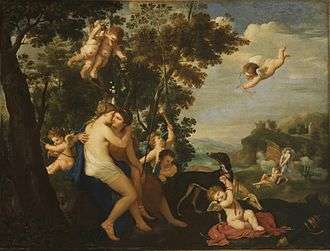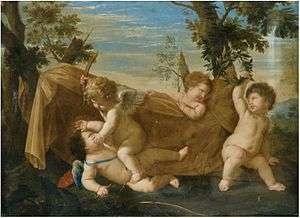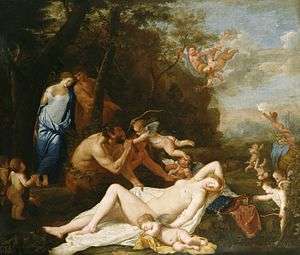Karel Philips Spierincks

Karel Philips Spierincks (many name variations: Spierinckx, Spierinck, Spieringh, Spiringh, Spirinck, Spirinx, Spirin, Carlo Filippo Fiammingo)[1] (c. 1600 or 1609-1610, Brussels – 22 May 1639, Rome) was a Flemish painter who spent his active career in Italy. He painted mainly landscapes with putti or mythological scenes in a classicizing style which show the influence of François Duquesnoy and Nicolas Poussin as well as religious paintings.
Life
The details about Spierincks’ early life and training are sketchy. This also applies to his date of birth. He is usually stated to have been born in Brussels c. 1609-1610. However, he is mentioned as a pupil of Michel de Boerdous in Brussels in 1612 and as a master in the Brussels Guild of Saint Luke in 1622. It is therefore more likely that he was born around 1600.[2] He was in Rome by 1624 and it is believed that he may briefly have been a pupil there of his Flemish compatriot, the landscape painter Paul Bril.[2]

By 1630 Spierincks is documented as sharing a house with the Flemish sculptor François Duquesnoy (1597-1643). The two artists lived together in via della Vittoria near Piazza di Spagna from 1630 until Spierincks’ death in 1639.[3] François Duquesnoy had previously shared lodgings with Nicolas Poussin.[2]
In the period 1634-35 Spierincks was paying dues to the Accademia di San Luca in Rome, though not as a member. He died on 22 May 1639 and was buried near the high altar of Santa Maria della Pietà in Camposanto dei Teutonici, a Roman Catholic church in Vatican City.[2]
Work
The work of Spierincks can be divided by subject matter into mythological and religious paintings. The two major influences on his style were Poussin and François Duquesnoy.[2] The influence of Duquesnoy can be seen in his Classicist tendencies and the theme of the putti.
Poussin had during his first decade in Rome (1624–34) created a series of mythological landscapes inspired by Titian’s series on the theme of the Bacchanales (one now in the National Gallery, London, and two in the Prado, Madrid) and on the pastoral love poetry of classical antiquity such as the Eclogues of Virgil. These Poussins are playful and erotic celebrations of the idyllic life of Arcadia but also have a serious undertone.[4] Spierincks was inspired by Poussin's paintings to produce a series of mythological paintings often depicting putti in a bucolic setting. His work is sometimes confused with that of another follower of Poussin, the Italian painter Andrea de Leone.[5]

Spierincks left incomplete paintings for the sacristy of Santa Maria dell'Anima which he had already started. These paintings have not survived although one of them, a Saint Norbert, was recorded on 2 March 1643 in the house of 'Petrus Piscator' i.e. Peter Visscher (or Pieter de Vischere), an Italian banker and patron of Flemish origin.[2]
References
- ↑ Biographical details at the Netherlands Institute for Art History (Dutch)
- 1 2 3 4 5 6 Silvia Danesi Squarzina, A 'Hagar and the Angel' by Carel Philips Spierinck in Potsdam, in: The Burlington Magazine, June 1999 (Number 1155 – Volume 141)
- ↑ Carel Philips Spierinck (Brussels c. 1600 – 1639 Rome), Putti Teasing a Goat, at Dorotheum
- ↑ Karel Philips Spierincks (c.1600-39) at the Royal Collection
- ↑ Miriam Di Penta, 'Due inediti di Andrea de Leone. Nuove riflessioni sul Poussin-castiglione-De Leone Problem', in Storia dell'Arte 125-126. 2010, p. 101
Literature
- Stefan Albl, 'Poussins Freunde: Pietro Testa und Karel Philips Spierincks', Die neue Ausgabe der Frühneuzeit-Info, 6 November 2013, p. 29-42
- A.F. Blunt, 'Poussin Studies X: Karel Philips Spierincks, the First Imitator of Poussin's Bacchanals', The Burlington Magazine 102 (1960), p. 308-311
- D. Bodart, Les peintres des Pays-Bas méridionaux et de la principauté de Liège à Rome au XVIIeme siècle, Brussel-Rome 1970, dl. 1, p. 137-140
- S. Danesi Squarzina, 'Il Silebo ebbro di Spierinck. Dai baccanali alla storia sacra', in: Roma luce ed ombra. Due dipinti tra terzo quarto decennio del seicento (Galleria Silvano Lodi & Due, TEFAF Maastricht), Milaan 2008, p. 44-95; speciaal p. 87-91: S. Danesi Squarzina & L. Lorizzo, 'Carel Philips Spierinck a Roma. Regesto documentario'
External links
 Media related to Karel Philips Spierincks at Wikimedia Commons
Media related to Karel Philips Spierincks at Wikimedia Commons